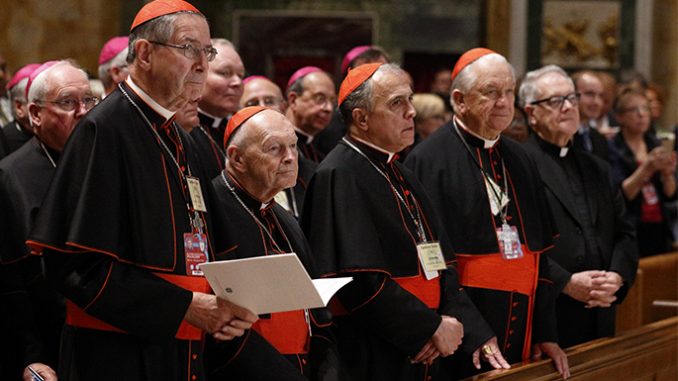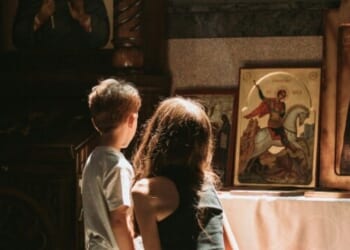
When Pope Francis’s coffin was sealed on Friday in St. Peter’s Basilica, Cardinal Roger Mahony was among the official witnesses.
If you are wondering why that matters, well, suffice it to say Mahony’s presence sends a signal.
Mahony was archbishop of Los Angeles for more than a quarter century, from 1985 to 2011, during which he grossly mismanaged abuse cases and even shielded priests who had abused children.
Mahony’s successor in Los Angeles, Archbishop José Gomez–who never got a red hat–stripped Mahony of his public duties in 2013, but Mahony continued to enjoy some favor in Rome.
To Catholics in the United States, especially, Mahony is not only a face of the scandal but a totem of the ongoing leadership crisis plaguing the Church.
The ceremonial reason for Mahony’s official role in the solemn occasion on Friday is that he is among the most senior “cardinal priests” in the College of Cardinals, which is divided into three ranks: Cardinal Deacons, who are the most junior members of the College; Cardinal Priests; and Cardinal Bishops, in general the most senior.
There was no necessary or non-derogable reason for him to have taken part in the business.
Mahony could have done the decent thing and demurred as he did in 2018, after public outcry over his unfortunate appointment as papal legate to the sesquicentennial celebrations for the Diocese of Scranton, Pennsylvania.
That was a cack-handed appointment over which people were more than merely nonplussed, and Mahony–not without a little help–found literally anywhere else on earth to be that day, but it was not so in Rome on Friday.
What signal does it send, then?
As Kathryn Jean Lopez noted in a piece for the National Review, the cardinal archbishop-emeritus of Los Angeles wasn’t the only American whose presence was something of a head-scratcher. The Camerlegno of the Holy Roman Church, who presided over the sealing rites and is responsible for the day-to-day operations in the Vatican during the interregnum, is none other than Cardinal Kevin Farrell.
Farrell began his ecclesiastical career as a Legionary of Christ, the congregation founded by the notorious Fr. Marcial Maciel, who used the priestly society he had founded as a respectable façade and a slush fund for his perverse double life. Maciel allegedly abused scores of victims, among them minors, seminarians, and his own illegitimate children, whom he had with at least two different women, whom he seduced under assumed names and false pretenses.
Farrell left the Legion before the mid-1980s, when he joined the clergy of the Archdiocese of Washington. Farrell said he “had intellectual differences” with the Legion, but “never knew anything back then,” about Maciel, in a 2016 interview with the Irish Times.
“[M]aybe I would have met Maciel once or twice, but I never suspected anything.”
In 2001—not a year after Theodore Edgar “Uncle Ted” McCarrick came into the see of Washington, DC—Farrell, who was DC’s Vicar General by that point, became an auxiliary bishop for the archdiocese. Farrell would serve as Vicar General and Moderator of the Curia in the capital see until Pope Benedict XVI gave him his own in Dallas, TX.
Pope Francis brought Farrell to Rome in 2016 to head the Dicastery for Laity, Family, and Life, and gave him a red hat.
When news of McCarrick’s depravities began to emerge in the summer of 2018, Farrell repeatedly denied having the slightest suspicion of his former principal, even though he had worked closely with McCarrick for many years and had even shared an apartment with him.
“People can say, ‘Well you must be a right fool that you didn’t notice.’ I must be a right fool,” Farrell told the Associated Press, “but I don’t think I am—and that’s why I feel angry.”
Either Farrell really never suspected anything, or he suspected something. Either way, it is reasonable to wonder at the trust placed in him.
So, perhaps the signal is white noise: Business as usual in the Vatican. After all, neither Farrell nor Mahony was ever convicted of a crime. Business as usual, however, is intolerable.
In another week or so, the cardinal electors will gather in the Sistine Chapel to elect the successor to Francis—the successor to Peter—and they will stand before God and each other as they cast their votes, swearing: “I call as my witness Christ the Lord, who is to judge me, that I choose him whom according to God I judge ought to be elected.”
Let an enlightened and clear-eyed understanding of the state of Church leadership culture inform their choice.
If you value the news and views Catholic World Report provides, please consider donating to support our efforts. Your contribution will help us continue to make CWR available to all readers worldwide for free, without a subscription. Thank you for your generosity!
Click here for more information on donating to CWR. Click here to sign up for our newsletter.









